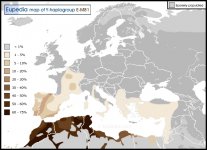I try to see what happens if at one point in time, two diferent populations, each with its own Y haplogruop, 1 and 2, mix together, let's say in proportion of 10 to 90. At the initial moment the haplogrup 1 population represent 10% of the mixture, and fertility is the same for both populations, but because of any biological reasons there is a difference between the number of boys and girls who are born in families of men of haplogrup 1 and 2. I assumed that from 10 offsprings, males 1 have 6 boys and 4 girls, and males 2 have 4 boys and 6 girls.
Then I calculated what would happen with the frequency of this two haplogroups in the mixed population over a few next generations.
1 .......... 2
(%) (%)
10........90
14,29...85,71 --> generation I (after 25-30 years)
20........80
27,27...72,73
36........64
45,76...54,24
55,86...44,14 --> generation VI (150-180 years)
65,5.....34,5
74,01...25,99
81.03...18,97
86,5.....13,5
90,57...9,43 --> generation XI (275-330 years)
93,51...6,49
95,58...4,42
97,01...2.99
97,99...2,01
98,65...1,45
99,09...0,91 --> generation XVII (425-510 years)
Since the sixth generation (150-180years), the haplogroups proportion already has changed in favor of Y haplogroup 1.
In about 275-330 years (eleventh generation), the proportion of haplogrope 1 (90,57%) already exceeds initial proportion of haplogroup 2 (90%).
Other important effects:
- Mitochondrial haplogroup of the population 2, which represented 90% at the beginning, will increase, reaching very close to 100% in a short time.
-Although haplogroup 1 has become overwhelming, in fact the initial autosomal genetic heritage proportion of the mixture is kept, 10 to 90.
If it has a correspondent in reality, this can explain many "sudden population extinctions" if we take into account only the chromosome Y. But these extinctions do not exist autosomaly!
I think it be one explainations of the fast expansion at high proportion of R1b, R1a, or other Y haplogroups.
So, probably, mixing with other small groups, many populations like Neolithic Farmers switch Y chromosome, but their genetic heritage remain at high level until today.
What do you think?


